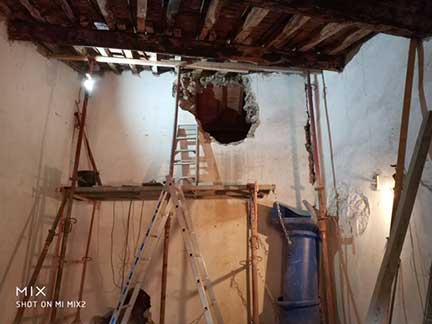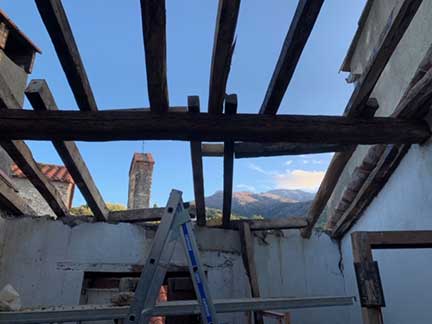









|
Under Construction |
||
|
What’s the Plan? Joining the two houses doubles the size … dollhouse no more! My goal is to create one integrated structure full of light, connecting on all levels, adding bedrooms, bathroom and toilet, fireplace, second terrace and storage. All exterior changes to my house require approval of the Mairie, and allowable changes to historic houses is very limited. Enlarging windows is allowed only in the vertical direction (Catalan houses didn’t have horizontal windows). No new windows permitted. To add a terrace, it must be built into the roof (not at the edge of the roof with a railing). Skylights ok. APPROVED! Interior changes require no permit or inspections, although there are building standards that must be followed. I am opening the ground floor arch on the to create a grand entrance from my current house. Adding a glass entry door and interior glass wall will create a light-filled bedroom on the ground floor. Vestibule for bikes and firewood. New large closet for washer/dryer, water heater and new full-size refrigerator. On the second level, tear out interior wall to create a large open room. Open the small window, in the vertical direction, for French doors and small balcony to make a light-filled room for dining and lounging. Restore the fireplace for ambience (and hopefully heat). Add master bedroom with skylights, second toilet, and bathroom on third level. Demolish mitoyene (common) stone wall 1 meter thick to gain space for stairs to new rooftop terrace on fourth level. Build support for roof that was supported on both sides by the stone wall. Build terrace set into the roof in the attic space with views to the Mediterranean and Pyrenees.
My little house, built in the 1300’s, was surely renovated over the years. There is evidence that a story was added judging from the slope of the stone in one of the outer walls. Certainly, it was fitted at some point for electricity and indoor plumbing. But the most significant change was in the 1980s wave of modernization ... out with the old beams and in with new concrete brick and plaster to conceal the stone walls. A very clean look. The idea was the air space between the walls would provide insulation. Nice wide new stairs replaced steep, narrow ones. Concrete replaced wooden flooring and joists. Typical Catalan houses only had one window per floor and mine now has two. We discovered the original window during a renovation of the second floor. About 2000, the prior owner converted one of the third-floor bedrooms into a terrace and reopened a window built in the outer wall and to their delight discovered a view to the Mediterranean. I purchased the house in 2008. When I renovated the second floor, I removed one of the concrete walls to restore the old stone wall. It’s magnificent and has a very small niche, maybe formerly a tiny window. The slope of the stone is evidence of the added story. But, restoring stone walls is an expensive proposition so I only dreamed of more stone walls. But then there was the peeling paint Concrete walls don’t breathe like stone ones, and the ground floor is built directly on the dirt. The old village is a big hill with views up and down the coast … an important stronghold of the King of Majorca when this area was part of Spain. The problem with being built on a hill is that water runs downhill and my street resembles a river in heavy rain. My moisture problem and peeling paint was vexing. I tried some vents in the concrete wall to get some air movement with no improvement. Restoring the stone wall was a beautiful solution. In the course of uncovering the stone wall we found a 10-foot-wide arch that has been sealed up. The irresistible question, “what was on the other side of the arch?” We drilled a small hole through to an open space … was the Templar treasure cached there? It was another tiny house on the street behind mine! I kept thinking about that magnificent arch ... was it an invitation? There was a mail slit in the door of this mystery house, and by shining a light I could see it was pretty much a ruin with no evidence anyone lived there. Through the Mairie I found the address of the owner. Still having a slight moisture problem in a concrete wall adjacent to the beautiful stone one, I contacted the owner on the pretext of my water problem. At last we agreed on a visit. No moisture just a primitive dwelling - ground floor for animals, second for living with small kitchen and chamber, third the hayloft. Amenities few- ladders for stairs, toilet just inside front door and basin on the ground with a hose (chateau d'eau), but stone walls with an arch. Remnants of fireplace in kitchen and soaring ceiling on 3rd. Only two little windows. The owner immediately surmised I might be interested in purchasing his little ruin. What ifs peppered my mind alternately with "Marilyn are you nuts!" Afin the nuts won and it was mine in July after a year of visits, negotiations, and work with architect. Planning permission in hand ... work began in August ... |
|
Photo Progress |
 The arch in the back wall of the ground floor. Beautiful old beams and stone walls to preserve 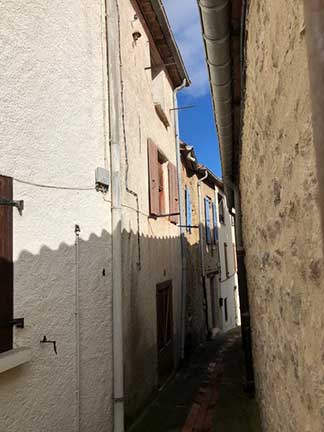 6 rue de la Sardane, narrow house with 2 windows opposite wall of church  Front door with the mail slot inviting the curious 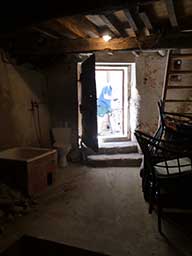 All the conveniences of home right inside the front door! 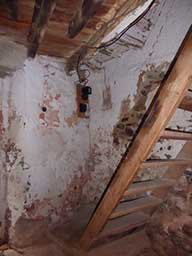 Electrical service ... I think there is only one circuit. Stairs to second floor 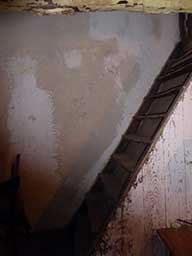 Stairs to third floor 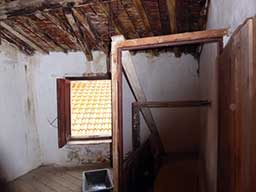 Third floor hayloft. The ceiling is hand-tied bamboo between the joists, more beautiful old beams 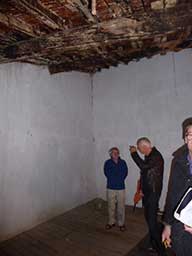 High ceiling on 3rd level makes it possible to build a terrace in the roof 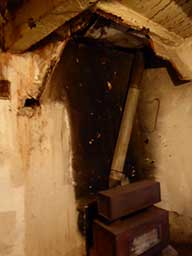 Once a fireplace ... maybe again? Second floor |
